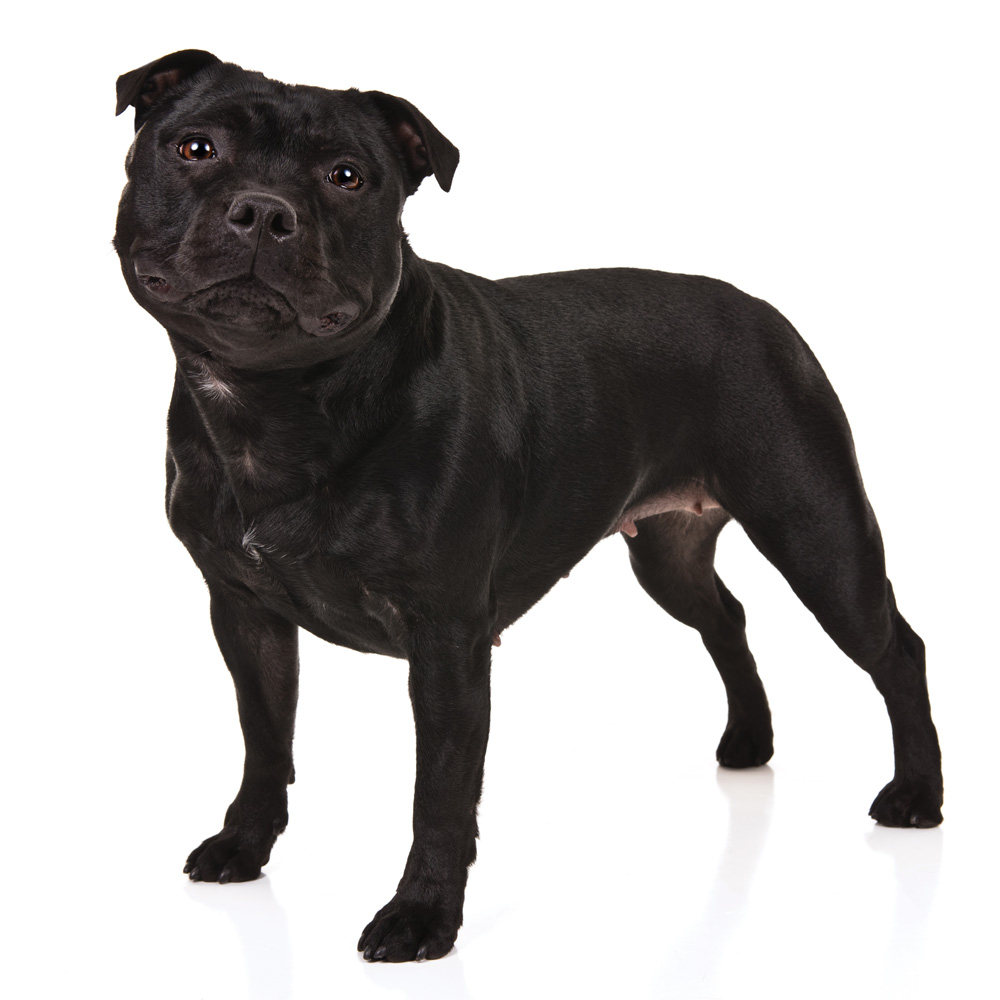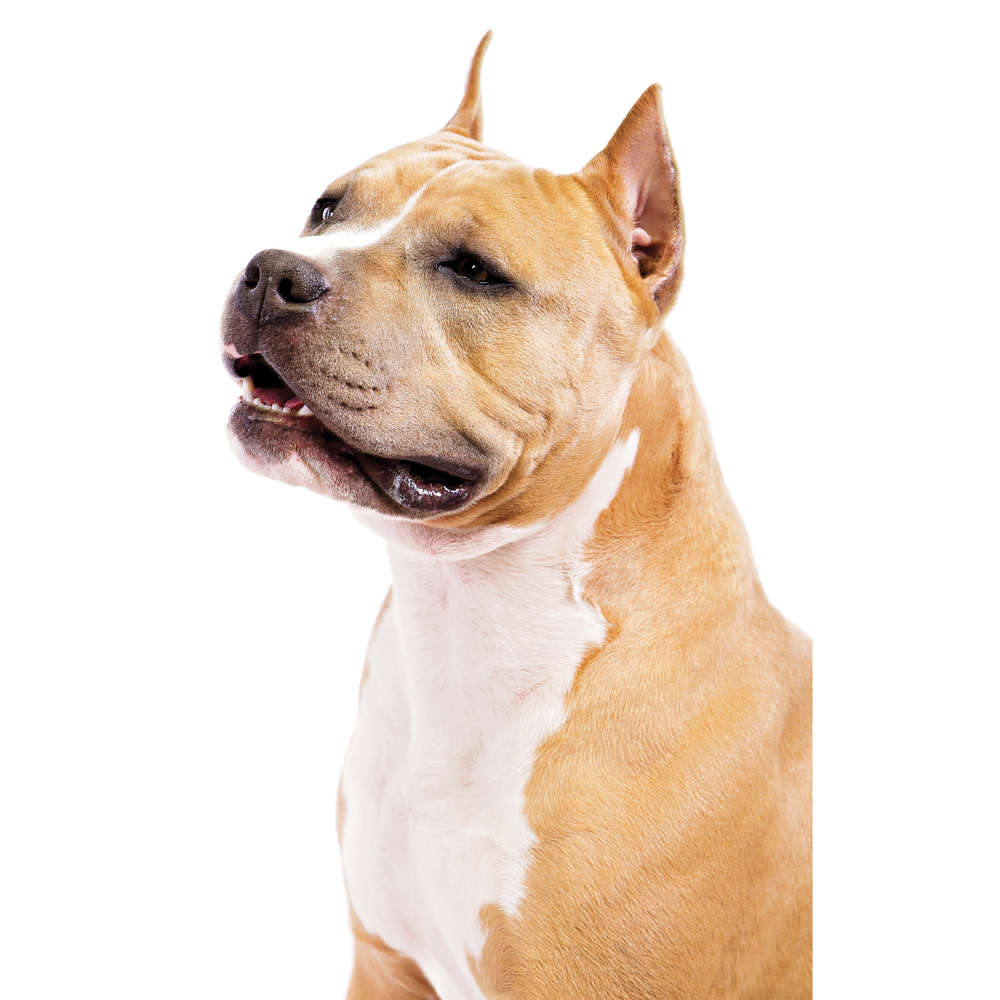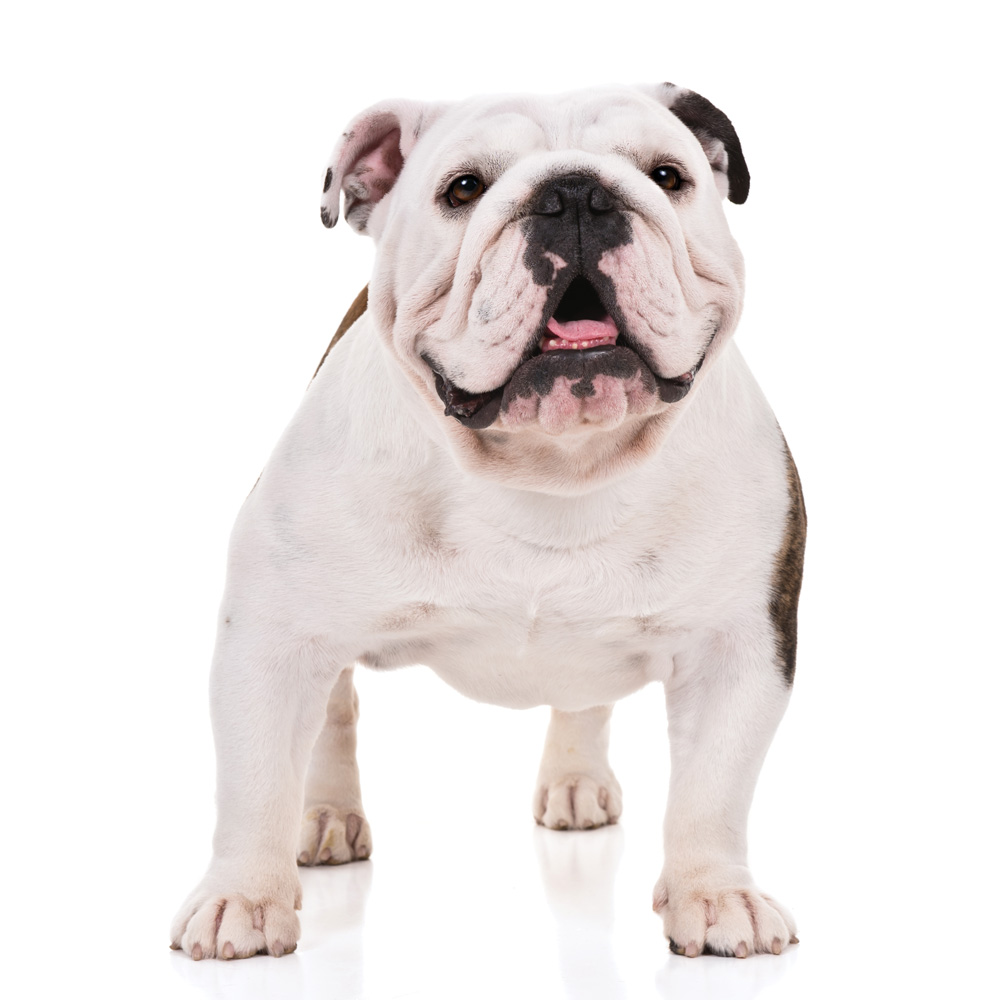

The Bull Terrier
A distinctive, muscular build renders this breed regal and impressive, yet in terms of personality, the BT is utterly comical and sweet-natured.

With an egg-shaped head and a swagger that’s unparalleled in dogdom, there is simply no mistaking the Bull Terrier. A distinctive, muscular build renders this breed regal and impressive, yet in terms of personality, the BT is utterly comical and sweet-natured. Is the Bull Terrier right for you? Let’s take a look at the breed’s history and what it’s like to live with a Bull Terrier.
Early History
As with all of this breed’s bull-and-terrier cousins, the Bull Terrier emerges from a group of feisty, muscular British terriers that were developed to participate in bull-baiting and dog-fighting. Thankfully, these blood sports were banned in England in 1835. By then, the dog that would become today’s Bull Terrier was known for being tough enough to “finish” a fight but unlikely to provoke one.
With dog-fighting outlawed, breeders focused on type and temperament with an eye to continue selling their dogs—but with a shift to their role as a
family companion with a knack for hunting vermin.
British-based dog fancier and breeder James Hinks had a particular dog in mind. He wanted to create a more refined bully breed—a gentleman’s dog, if you will. A solid, bright white coat for the breed was a priority because Hinks had a hunch that this would appeal broadly to dog fanciers.
As was usual for the time, Hinks didn’t keep detailed records of the breeds that he used to create the Bull Terrier. We do know that Bulldog was used, as was the Dalmatian and the now-extinct White English Terrier—the latter two notably to introduce the all-white coat that sets the breed apart. Some speculate that Greyhounds or Pointers may have been introduced to straighten the legs that would naturally have bowed owing to the Bulldog heritage.
By introducing a diverse mix of breeds, the Bull Terrier over time came to look entirely distinct from its bully cousins. The neck and foreface became longer, and eventually the Bull Terrier ended up with an egg-shaped head with small, triangular eyes—both of which are unique in the dog world.
Hinks wasn’t just concerned with the breed’s appearance. He was also trying in earnest to create a bully breed with a gentle temperament—one disinclined to fight and ideally suited as a family companion.
Most Popular Dogs in the US
According to the most recent AKC registration statistics (2023)
[1] French Bulldog
[2] Labrador Retriever
[3] Golden Retriever
[4] German Shepherd
[5] Poodle
[6] Bulldog
[7] Rottweiler
[8] Beagle
[9] Dachshund
[10] German Shorthaired Pointer
[65] Bull Terrier
Dog Show Debut
In 1862, Hinks entered his “New Bull Terrier” at a dog show in Birmingham. His hunch was right, and people were immediately drawn to the breed’s unique appearance and calm, good-natured temperament. Hinks’ goal of creating a gentleman’s terrier was realized, and the breed earned the nickname of “The White Cavalier.”
Soaring in popularity, Bull Terriers made their way to North America soon enough. The American Kennel Club (AKC) recognized the breed in 1885, and the Bull Terrier Club of America (BTA) was founded in 1897.
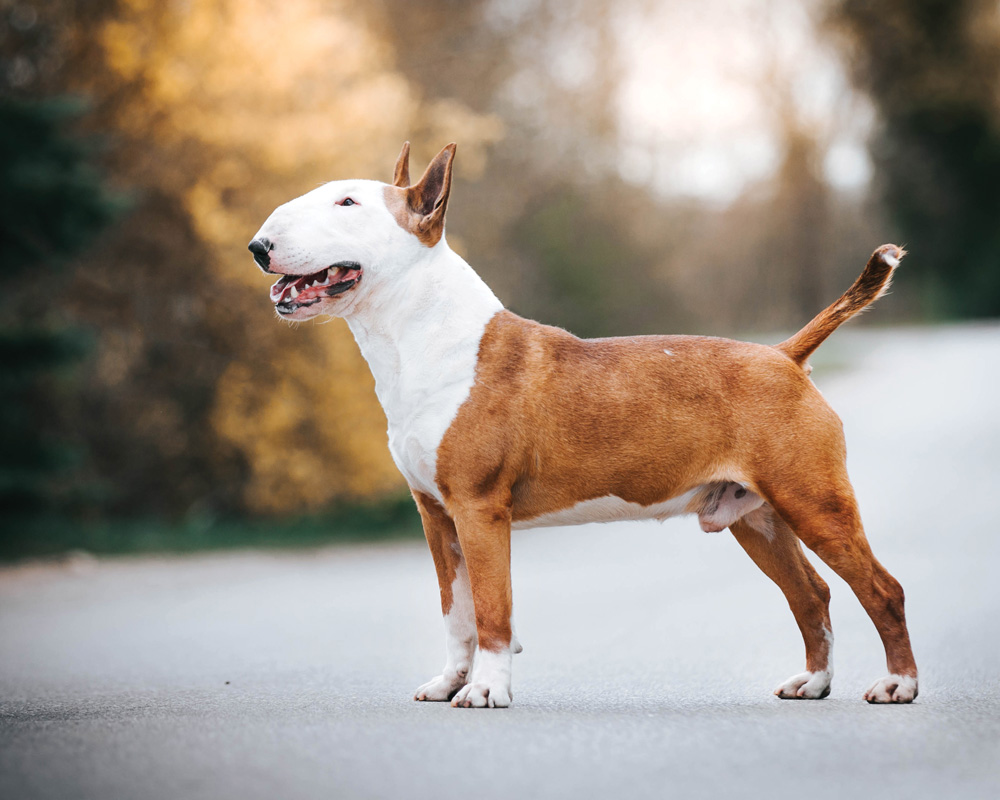
Photo photography/shutterstock
Evolution of the Standard
In the 20th century, Bull Terrier fanciers focused their energies on developing a breed standard and introducing coat colours. Breeders used the Staffordshire Bull Terrier for this purpose, creating breeding lines that would yield the different colours, brindling, and markings that are part of the Bull Terrier today.
A muscular and well-proportioned breed, the Bull Terrier stands 21” to 22” at the withers; weights range considerably, from 35 to upwards of 70 pounds.
The standard emphasizes strength in build, an intelligent expression, and eyes with a “piercing glint.” The ears are small and placed close together, standing quite erect and pointing upwards. The Bull Terrier’s tail is short, thick, and carried horizontally.
Get to Know the Bull Terrier
- Medium or small: Two varieties to choose from
- Even-tempered, friendly, and loving.
- High energy; renowned for the “zoomies”
- Fun-loving and clown-like
- Strong attachment to family
- Good with children
- Early training and socialization are musts!
- Head-strong, mischievous, and a bit naughty
A Smaller Version: Meet the Miniature Bull Terrier
Those in search of a more compact version of this enchanting breed are in luck. While working hard to establish type and temperament in accordance with the standard, efforts were also underway to create a smaller version of the breed. The Miniature Bull Terrier was recognized by the AKC in 1991 and is virtually identical to the Bull Terrier in every way but size. The Mini Bull weighs between 18 and 28 pounds, and his height ranges from 10” to 14” at the withers.
What is it Like to Live with a Bull Terrier?
Living with a Bull Terrier is like having a rambunctious toddler in the form of a dog. This is a happy-go-lucky, extroverted, and highly energetic breed. The Bull Terrier is one of the dog world’s natural-born comedians with a keen interest in having fun. This breed is an excellent choice for those with active lifestyles in search of an up-for-anything companion. The Bull Terrier’s boundless energy must be chanelled. The bored Bull Terrier can be destructive, noisy, and anything but the gentleman’s companion that Hinks had in mind! This breed is very devoted to its family and has earned a reputation for being exceptionally good with kids. Supervision around young children is, of course, advised—that muscular build plus playtime exuberance can easily knock down littles unintentionally. For older kids, the Bull Terrier is an ideal playmate with plenty of energy and a very fun personality.
Training and Socialization
This dog wants to go, go, go. An active lifestyle is required for the breed to thrive, but to be clear: naturally obedient the Bull Terrier is not.
Bull Terriers, like their bully cousins, are quite strong-willed. They’re intelligent dogs but possess a natural tendency to do what suits them at any given moment.
Early training is an absolute must. The Bull Terrier can easily become the unruly boss of a household unless firm and consistent training and leadership are in place. For this reason, the Bull Terrier is not a suitable choice for everyone. Those bringing a Bull Terrier into their home must be prepared to put the time and patience required into obedience training.
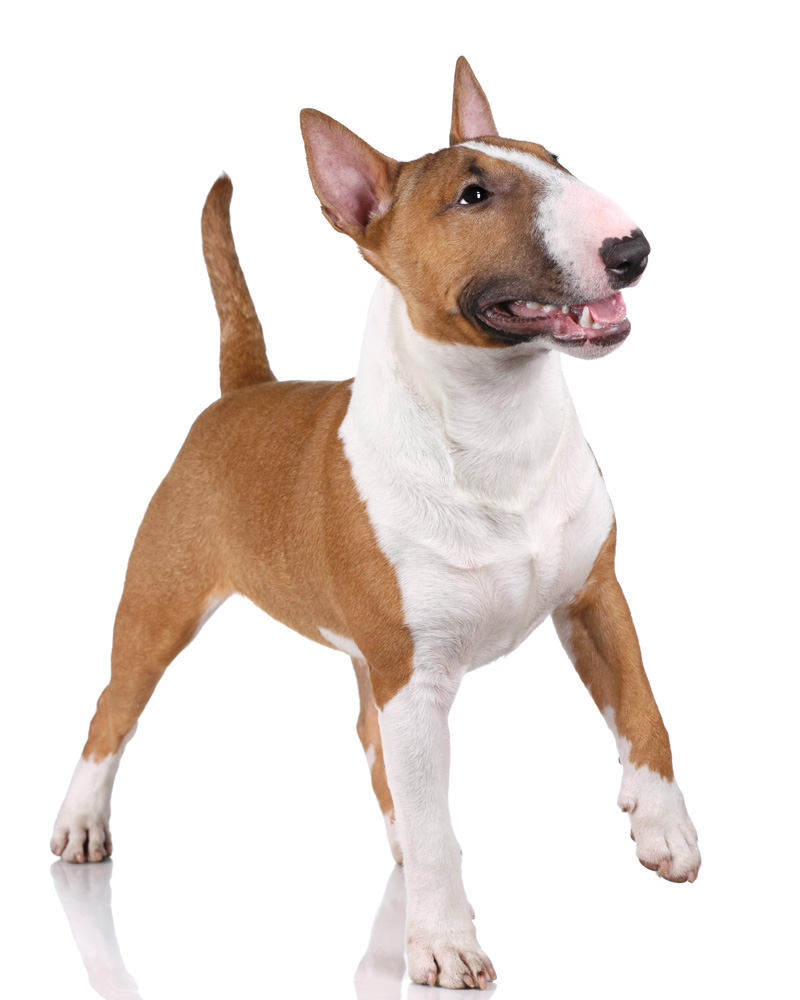
Photo Ivanova N/Shutterstock
Motivation is key when it comes to training the Bull Terrier. Sure, this is perhaps the most chill member of the Terrier group but is not immune to that trademark stubbornness. Fortunately, the breed is notoriously food-motivated, a trait that comes in very handy for training purposes.
Early socialization with other dogs and pets is also vitally important. While even-tempered, the potential for the Bull Terrier to become aggressive with other dogs exists.
Profile: The Bull Terrier
Size: Medium or Small
Weights range from 18-70 pounds, and heights from 10″ to 22.”
Activity Level: 4/5
This is an energetic breed. After bursts of high energy, expect long naps.
Grooming: 2/5
The sleek and shiny coat of the Bull Terrier requires just a simple brushing, once a week.
Heritage: Emerging from a group of Terriers bred for dog-fighting, the Bull Terrier was designed to be a regal and even-tempered companion.
For more information on Bull Terrier rescue in the U.S., visit bullterrierclubofamericarescue.com. In Canada, visit thebullterrierclub.ca/rescue.
Out and About with this Bully
The Bull Terrier is an active breed. At an absolute minimum, daily walks and plenty of play time are needed, but to thrive, this breed needs more—a few long walks a day and ideally a fenced-in yard for him to zoom around in when he pleases.
Is he the easiest of dogs to introduce to canine sports? Not really! Again, that independent and stubborn terrier streak is in there. But, for those who commit to giving this special breed the time and attention involved, the well-mannered and obedient Bull Terrier is a dream.
Once the BT has mastered the basics of Obedience, consider introducing fun sports like Agility or Flyball. Fun, physical outlets are right up the Bull Terrier’s alley and can be a great way to channel all that energy and exuberance.
If you like the Bull Terrier, you might also consider the…
Photos Thomas Pitera © American Kennel
Staffordshire Bull Terrier American Staffordshire Terrier Bulldog
» Read Your Breed For more breed profiles, go to moderndogmagazine.com/breeds
This article originally appeared in the award-winning Modern Dog magazine. Subscribe today!
Join the newsletter and never miss out on dog content again!
"*" indicates required fields
By clicking the arrow, you agree to our web Terms of Use and Privacy & Cookie Policy. Easy unsubscribe links are provided in every email.
